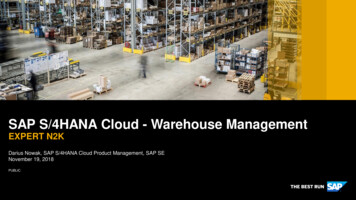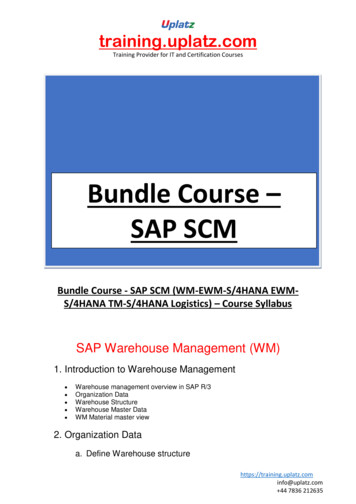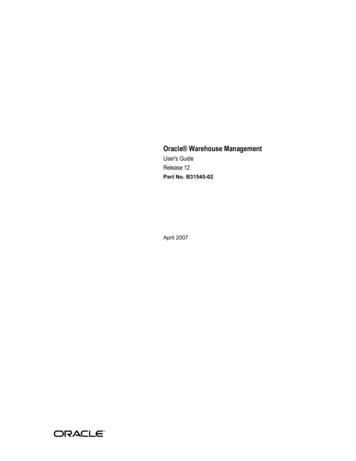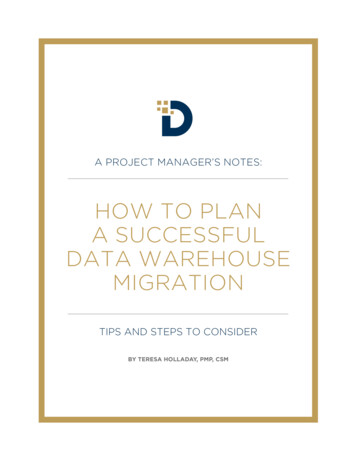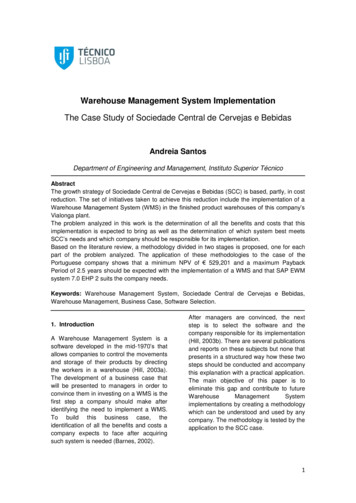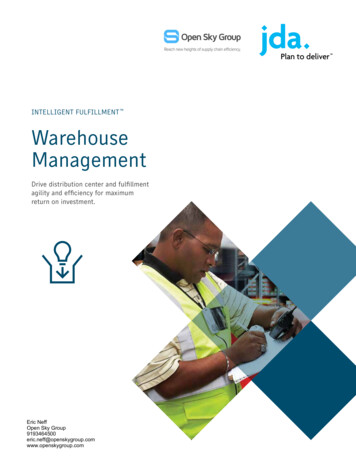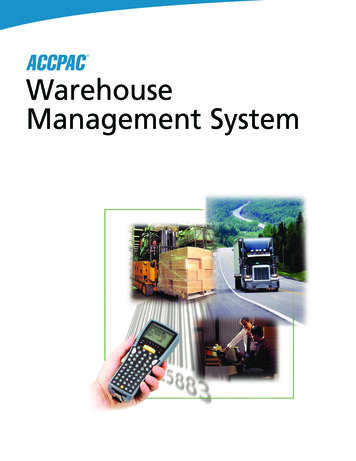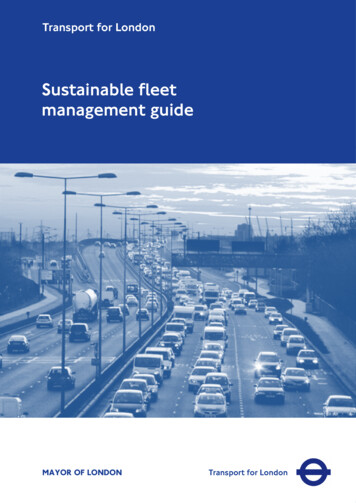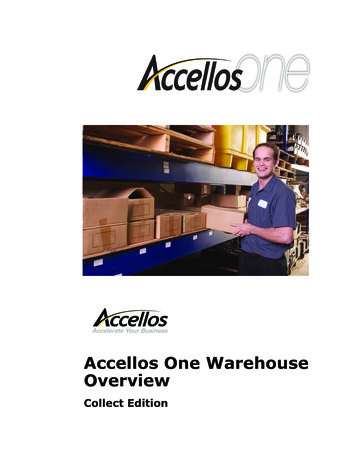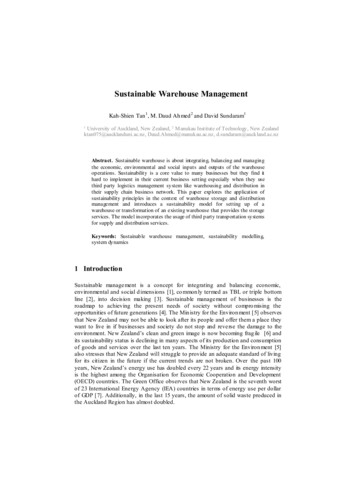
Transcription
Sustainable Warehouse ManagementKah-Shien Tan 1 , M. Daud Ah med 2 and David Sundaram1University of Auckland, New Zealand, 2 M anukau Institute of Technology, New Zealandktan075@aucklanduni.ac.nz, Daud.Ahmed@manukau.ac.nz, d.sundaram@auckland.ac.nz1Abstract. Sustainable warehouse is about integrating, balancing and managingthe economic, environmental and social inputs and outputs of the warehouseoperations. Sustainability is a core value to many businesses but they find ithard to implement in their current business setting especially when they usethird party logistics management system like warehousing and distribution intheir supply chain business network. This paper explores the application ofsustainability principles in the context of warehouse storage and distributionmanagement and introduces a sustainability model for setting up of awarehouse or transformation of an existing warehouse that provides the storageservices. The model incorporates the usage of third party transportation systemsfor supply and distribution services.Keywords: Sustainable warehouse management, sustainability modelling,system dynamics1 IntroductionSustainable management is a concept for integrating and balancing economic,environmental and social d imensions [1], co mmon ly termed as TBL or triple bottomline [2], into decision making [3]. Sustainable management of businesses is theroadmap to achieving the present needs of society without compro mising theopportunities of future generations [4]. The Min istry for the Environ ment [5] observesthat New Zealand may not be able to look after its people and offer them a place theywant to live in if businesses and society do not stop and reverse the damage to theenvironment. New Zealand’s clean and green image is now becoming frag ile [6] andits sustainability status is declining in many aspects of its production and consumptionof goods and services over the last ten years. The Ministry for the Environ ment [5]also stresses that New Zealand will struggle to provide an adequate standard of livingfor its citizen in the future if the current trends are not broken. Over the past 100years, New Zealand’s energy use has doubled every 22 years and its energy intensityis the highest among the Organisation for Economic Cooperation and Development(OECD) countries. The Green Office observes that New Zealand is the seventh worstof 23 International Energy Agency (IEA) countries in terms of energy use per dollarof GDP [7]. Additionally, in the last 15 years, the amount of solid waste produced inthe Auckland Region has almost doubled.
Proceedings of EOMAS 2009Ministry for the Environment emphasises on the performance of the threesustainability dimensions [5] and the New Zealand Business Council fo r SustainableDevelop ment stresses that sustainability is not just an option but a require ment formany businesses in New Zealand [9]. Sustainability is now becoming a necessity asstakeholders and society place higher expectations on companies, expecting them notonly to be profitable businesses but also to be socially [10] and environ mentallyresponsible for their act ions. While many co mpanies have ju mped onto thesustainability bandwagon, sustainability is still a relat ively new concept to mostbusinesses as far as strategy development, business process transformation andimplementation are concerned.Economic, environ mental and social dimensions of businesses are inter-related(Fig. 1.) and any change in the objectives of a dimension greatly influences the othertwo dimensions. Therefore, if the company had considered each of the sustainabilitydimensions independently and made decisions without considering all possibleconsequences of their decisions, any attempt to become a sustainable business wouldbe unsuccessful. The first step in transforming a company into a sustainable businessis to develop a sustainability vision and sustainability strategies that includesustainability objectives. In order fo r business strategies to be successful, they needto be derived from the organisational resources and experiences [11]. However,current sustainability visions and strategies are mostly a personal vision of topmanagement which are not realistically supported by the organisation’s resources,processes, and knowledge-base. This lack of consideration and poor execution ismainly due to the lack of frameworks and tools which can foster a real understandingthat each of the three dimensions are inter-related and demonstrate the dynamicrelationships the three sustainability dimensions have with each other.Socio-EconomicIndicatorsSustainability DimensionsEconomicEnvironmentalEconomic . 1. Inter-relationship among the sustainability dimensions of the businessThis paper explores sustainable warehouse modelling in the context of an o rganisationthat provides storage and transportation services. We model the sustainability issuesof warehouses in general and then apply it in particular to the firm under study. Weclose the paper with a brief description of the imp lementation of the models and thedevelopment of a system that enables us to monitor the triple bottom line scorecard.
Proceedings of EOMAS 20092 Sustainable Warehouse ManagementSustainable supply chain management is the “Management of raw materials andservices from suppliers to manufacturer / service provider to customer and back withimprovement of the social and environmental impacts exp licit ly considered.” [9]Decreased barriers to trade and improved technology [12] has allowed businesses andsupply chains to expand across regions and countries, further increasing the need forthe sustainable management of supply chains. Furthermore it is inadequate forbusinesses to promote sustainability only within their own company, entire supplychains have to be managed in a sustainable fashion in order for business to remaincompetitive. Benefits of sustainable supply chain management include increasedbrand appeal, sales loyalty and stakeholder satisfaction as well as reduced negativeimpacts on society and the environment [9]. Having a sustainable supply chain wouldalso improve transparency and visibility along the chain allowing co mpanies to beable to respond quickly to changes in the market and other situations.One of the key co mponents within the supply chain is warehousing. Mostwarehousing and transportation companies have little regard for the environmentalimpacts of their actions and do not understand the social consequences of theirbusiness activities. These companies consider factors such as cost effectiveness andcustomer satisfaction as the main performance indicators [13], [14]. Linton andQuariguasi Frota Neto argue that being involved in the storage and transportation ofgoods, these companies have to recognise the importance of transforming theircurrent business model into a sustainable one. An added impetus to the argument isthat vehicle emissions are one of the majo r sources of pollution.This research undertakes a real-life sustainable warehouse management project inAuckland for an ISO cert ified warehousing company. The company provides storagefacilit ies for chemical and food items in Auckland and Christchurch for variouscustomers and delivers the goods to various manufacturing and retail businesses allover New Zealand. Various small to large transportation companies are also workingin collaboration with the company in the transportation and delivery process. Thewarehousing company is growing rapidly and thus wishes to increase capacity byestablishing more warehouses. The co mpany’s operations management processes arewell-defined but due to shortage of skilled workforce, recent developments in healthand safety, and environmental regulations as well as pressures from the sustainabilityaware members of its supply-chain, clients and the end users, the company decided toredesign the business processes for the new warehouses that follow sustainabilitymanagement approach and achieve competitive advantage within a short period.Major issues like employee retention, compliance and environmental footprints, andfinancial return are associated with the location of the warehouse. Therefore, theselection of warehouse location is an important strategic issue that would have amajor impact on economic, environ ment and social dimensions of the entiremanagement of the business. We highlight some of these issues in the remaining partof this section.Due to the nature of the goods handled, the company has to meet a large varietyand number of compliance regulations such as health and safety, hazardous goodsstorage and handling, food items storage and handling, environ mental co mpliance toname a few. It is obligatory for all employees to be highly trained in the compliance
Proceedings of EOMAS 2009processes. Thus it is hard to recruit skilled employees ranging from managers towarehouse operators who are needed to handle the chemical and food items. Ideally,the company would want zero employee turn over in order to minimise new stafftraining costs and achieve beyond the statutory compliance obligations to become aleader in the niche market.Currently, the company’s distribution system is entirely dependent on the roadtransportation network. Vehicle pollution is one of the biggest causes ofenvironmental pollution in New Zealand, thus in the effort towards becoming asustainable business, the warehouse should be located such that the pollutiongenerated is minimised. This can be achieved by either locating closer to the end usersor in a place that enables them to utilise alternative forms of environ ment friendlytransportation. In the pursuance of providing maximu m stakeholder satisfaction, thecompany also intends to invest a good proportion of their budget in in formation anddecision support systems to aid effective decision making. The majo r stakeholders ofthe company are customers, retail/ manufacturing centres, end consumers,transportation companies, consultants, accountants, employees and governmentdepartments.With the aim of helping the company become a leading sustainable warehousemanagement company, the authors undertook a research project to develop asustainability systems model. While keeping the issues discussed earlier in mind, thismodel will be used to simu late and analyse sustainability key performance ind icatorsdetermined fro m the crit ical success factors of a sustainable warehouse. The modelwill also support them in strategic decision making towards becoming a leadingsustainable warehouse management company.A sustainable warehousing company would not only have to consider the economicfactors, such as rent and operations costs, but also balance the social andenvironmental effects that occur within the warehouse compound as well as itssurrounding vicinity. Th is research places an emphasis on developing a balancedscorecard in conjunction with a sustainability model to help select a suitable locationfor a warehouse. The selection depends on the supply and delivery locations of thecustomers and the end users, transportation choices to and from the warehouse, andskilled staff availability and their job satisfaction.3 Modelling the Sustainable WarehouseThe sustainable warehouse management system can easily be broken down intosimp ler and more manageable parts for modelling [15]. However, modelling inisolation is not sufficient; it is the relat ionship and interaction between the parts thatare impo rtant [16]. Sustainability models can be developed using a systems thinkingapproach and this helps in shifting the focus from indiv idual effects to interconnectedsystems [17] to shape organisations and their processes. Therefore the sustainablewarehouse management model needs to address the inter-relationships of economicobjectives, employee welfare and minimisation of environmental impacts in anintegrated fashion.
Proceedings of EOMAS 2009Maani and Cavana observe that the study and management of a comp lex feedbacksystem can only be done using system dynamics/ systems thinking modellingmethodologies [18]. On ly the study of the system as a whole will lead to effectivesolutions and establish a win-win -win proposition for the three dimensions. ThereforeiThin k, a modelling tool that supports system dynamics , was chosen. iThink is usefulfor modelling dynamic relat ionships such as social issues (e.g. health, safety,recruit ment, retention, working hours, wage, job satisfaction, training, etc. );environmental issues (e.g. carbon minimisation, recycling, solid waste, air pollution,water pollution, etc); and economic issues (e.g. capital investment, warehouse rent,transportation cost, handling cost, packaging, information systems, hire cost, etc ).Firstly, a cause-effect diagram was constructed to demonstrate the interdependenceamong the various issues and present an influence diagram. Then, the relat ionshipsamong the factors were established.Subsequently, an interactive game which demonstrates the interdependentrelationships between the three sustainability dimensions was created. This allowsusers to gain a better understanding of how a decision will affect each of the threesustainability dimensions.While the warehouse’s location was the main decision problem, other decisionparameters were required to design a sustainable model. So me of the major decisionparameters include: Capital investment : to imp rove staff efficiency and reduce manual labour Nu mber of emp loyees : to ensure employees are not overworked Emp loyee Training: to ensure high employee productivity and effectiveness andcontinuous up skilling Carbon minimisation: carbon credits, planting trees and air filtering Transportation decisions: various modes of transport have significant differencesin carbon emissionsA sustainability scorecard was created to monitor the status of various keysustainability performance indicators. Some of the main tracking parameters includeCash flow, Warehouse utilisation, Carbon emissions and minimisations , Orderprocessing time, Emp loyee job satisfaction, Social and environ mental impacts onsurrounding areas (e.g. nearby residents).4 High Level Vie w of Sustainable Warehouse ManagementFig. 2. represents a high level view of a sustainable warehouse model. Theinterdependencies of the three sustainability dimensions are depicted by arrowscutting across dimensions. The tradeoffs and interdependent relationships are furtherdiscussed in Section 6.In a warehouse, Goods processing involves processing of inward goods and orders.The rate of processing is determined by the staff’s level of job satisfaction andproductivity. If the employees are not able to process the required orders, thecustomers’ satisfaction decreases leading to poor business relationships. Once the
Proceedings of EOMAS 2009orders have been processed, they are transported to the customer’s clients. Theprocess of delivering goods to their destinations results in large amounts of carbonemissions produced by the transportation fleet. In order to offset the carbonemissions, at least one of the Carbon minimisation activities will have to beperformed, leading to an increase in costs.Fig. 2. High level view of a sustainable warehouse model5 System Dynamics Warehouse Management ModelsThis section discusses the individual dimensions of the warehouse managementmodel that was developed using system dynamics modelling concepts. Beforediscussing the dynamics of a sustainable warehouse model, the purpose of eachelement used in the model is defined. In this instance, a stock and flow model wasused to represent the sustainable warehouse model. Elements of a stock and flowmodel consist of: Stocks, Flo ws, Converters and Connectors. Each of these elementsis further described below.StockA stock represents the accumulation of either a physical or non physical quantity e.g. number of orders, customer satisfaction.FlowA flow represents an activity which fills up or depletes a stock. Thearrow indicates the direction of positive flow into or out a stock.ConverterA converter can hold values for constants or serve as an externalinput to the model or convert inputs into outputs through userdefined algebraic relationships or graphical functions.ConnectorConnectors provide the links between models elements. Solid wireis an action connector and dashed wire is an informat ion connector.
Proceedings of EOMAS 20095.1 The Economic ModelFig. 3. is a snapshot of the main economic model of a sustainable warehouse. Thestock that is central to the economic model is Warehouse inventory. When a customersends an order to the warehouse, it is added to the Order backlog. The number of staff(i.e. Hours available for processing orders) and inventory on hand will determine thenumber of orders processed (Orders filled) and delivered. Any orders that cannot beprocessed, due to the shortage of either staff or inventory, will remain in the Orderbacklog until the next run. Warehouse utilisation which considers the effectivenessand efficiency of space usage is also an important economic factor to monitor in thewarehousing business.Number ofCustomersDissatisfiedcustomers leavingLost customerspalletsavg pallets\customerOutward goodsInward einventoryHours available forprocessing ordersOrderbacklogOrdersOrders filledFig. 3. Economic model of a sustainable warehouseThe warehouse company wants to maintain a high capacity utilisation rate toensure maximu m pro fits. Thus if utilisation is consistently low, it is an indication thatthe company should seek to obtain new customers by means of promot ions oradvertising. On the other hand, if the warehouse is over utilised, the company willhave to consider increasing their warehouse capacity or rent short -term storagefacilit ies for excess inventory at a greater than average cost. The company should alsotry to maintain a high level of customer satisfaction by ensuring that goods aredelivered on time or the company might run the risk of losing some of theircustomers.5.2 The Environmental ModelA high level model showing a few factors that influences the environmentaldimension is illustrated in Fig. 4. This model shows the main inflo ws (Emissions) andoutflows (Minimisations) of the Carbon emissions stock. Carbon emissions (Totaltransportation emissions) are generated by the company’s transportation fleetcomprising of vans, small and large trucks. As the vehicles are highly utilised, theirefficiency deteriorates over time thus producing higher levels of carbon emissions.The warehouse company can minimise this by regularly maintaining and upgradingtheir vehicles (Transportation fleet upgraded). The company may offset their carbonemissions by planting trees (Carbon absorption by trees) or purchasing Carboncredits.
Proceedings of EOMAS 2009Buy carboncreditsTransportationfleet upgradedTotal n absorptionby treesMinimisationFig. 4. Environmental model of a sustainable warehouse5.3 The Soci al ModelThe social dimension of the sustainable warehouse is very complex and containsmany elements. For the sake of simp licity, a simp lified social dimension model ispresented in Fig. 5. This model represents the social effects of a warehousingcompany with respect to its employees . The main stock in this model is JobSatisfaction. It is an index which has a maximu m value of 100. The job satisfactionof the warehouse employees is very impo rtant. This will be discussed further inSection 6.Factors such as hours per employee per week (Work hours/person), the amount ofStaff training and support provided and Capital investments, like new equip ment andsoftware to aid emp loyees in their work, all have an effect on their level of jobsatisfaction. If emp loyee Job satisfaction drops below a certain level, staff membersstart to leave the company, resulting in having to hire mo re staff, thus incurringrecruit ing and new staff train ing costs.StafftrainingWork hours\personNumber of staffAdd\remove staffCapitalinvestmentStaff quitsJob satisfactionchangeJob satisfactionFig. 5. Social model of the sustainable warehouse6 Inte ractions between the Sustainability Models/DimensionsHaving briefly discussed the inter-relationships of the sustainability dimensions inSection 4 and Fig. 2, th is section is dedicated to demonstrating some of therelationships between the three sustainability dimensions in the sustainable warehousemodel.6.1 Environmental – Economic – SocialIn order for the company to move towards sustainability, they have to consider andbalance the tradeoffs between minimizing costs as well as being both environmentally
Proceedings of EOMAS 2009and socially responsible. As previously shown in Fig. 4, so as to offset their Carbonemissions, the company will have to purchase Carbon credits, plant trees or minimisethe emissions from their transportation fleet. All three Carbon minimisation optionswill increase their expenses, which might lead to lesser funds being made availablefor Staff training and Capital investments. Inadequate staff training and capitalinvestments will lead to poor job satisfaction and low productivity. This is furtherdiscussed in the Section 6.2.Another factor the company needs to consider is that the trees will require a coupleof decades before they are able to provide the full benefits of carbon absorption. Thus,they may wish to consider purchasing Carbon credits as a short term solution wh ileplanting trees as the long term but more cost effective solution . In either case, thecompany should minimise inevitable carbon emissions by maintain ing vehicleefficiency as it is important to consider the effects of carbon emissions on society,especially in areas along delivery routes.6.2 Social – EconomicFollowing on fro m Sect ion 6.1, choosing not to hire more staff when required mightresult in short-term savings but will be detrimental to the company in the long run.This is because, the number of staff determines, on average, the number of Hoursavailable for processing orders. Thus, a shortage of staff will result in employeeshaving to work excessive hours over a long period of time to try reduce the Orderbacklog. This results in decreased Job satisfaction due to increased stress andtiredness. Poor job satisfaction will also lead to low morale and higher risks ofmaking mistakes, therefore causing a drop in overall productivity. A drop inproductivity means the average order processing time also rises, further increasing theOrder backlog.High levels of backlog will lead to poor customer satisfaction and retention. If acustomer is lost, not only will the company have to spend more money finding newcustomers, the loss of reputation and increased negative word of mouth will haveharmful long term effects.7 Implementation of the Sustainable Warehouse ModelsTo imp lement the models, the modelling software tool iThin k 9.0.2, fro m iSeeSystems, was used. iThink uses stock and flow d iagrams to model and simu lateprocesses and scenarios. It shows you the outcomes of certain user-defined inputs andcommunicates the interdependencies between processes and problems. Outputs can bedisplayed in the form of graphs, tables and warning gauges. In this instance, dynamicsystems modelling techniques were used in the creation of this model. The process ofcreating the model in iThink was an iterative process. It started with a very simplewarehouse inventory model (Fig. 3.) consisting of one stock (Warehouse Inventory),one inflow (Inward goods) and one outflow (Outward goods). This model was thentested to ensure that the relationships defined were correct. Once, this was verified,more elements such as Order Backlog and Number of customers were added. Again
Proceedings of EOMAS 2009this was tested before new elements were added. The whole process of building theentire model was carried out in this manner to allow ease in identify ing errors in themodel.7.1 System WalkthroughFig. 6. shows the main user interface of the simu lation model. There are six mainsections on this user interface; the Sustainability Scorecard, the Economic inputs, theSocial inputs, the Environmental inputs, the Comparative Charts and the Run section.The Sustainability Scorecard consists of three indicators; Revenue, Job Satisfactionand Carbon Emissions. Revenue is the average revenue from all three locations. If thedecision maker clicks on Details, the decision maker sees another page with theindividual co mponents that affect revenue. Thus if Revenue enters the “High Alert”(red) stage, the decision maker is then able to drill further down into the details todetermine wh ich type of expenses was causing a drain in finances. For example, thewarehouse may have been paying too many employees while there is little work to becarried out. This indicates that the decision maker might have to fire an emp loyee toreduce costs. The decision maker can carry out the same operations for the socialindicator, Job Satisfaction, and the environmental indicator, Carbon Emissions. Thedecision maker also has the option, at any time, of reviewing previous simu lationresults for the three main indicators by choosing one of the choices in ComparativeCharts. The Custom Detail button leads the decision maker to a page where theywould be able to customise their o wn graphs or data tables.Fig. 6. The Sustainable Warehouse M anagement Simulation Interface
Proceedings of EOMAS 2009The Economic input section allows the decision maker to determine the amount ofMarketing Expenses (to obtain new customers) and Capital investment for eachmonth. These values are reset to zero after each month. The Social input sectionallo ws the decision maker to define the level of Staff Training available to improvejob satisfaction and Hire or Fire Staff according to the amount of work availab le. Inthe Environmental section, the decision maker Buys Carbon Credits or Plants Treesto offset their carbon emissions. They are able to optimise the efficiency of theirtransportation fleet by choosing a transport mode to upgrade or enforce a newselection rule for the transportation company.To begin the simu lation, the user chooses all the values of the inputs that aredesired, and then clicks the Run button. The simu lation runs for one quarter andpauses to allow the user to review the effects of the decisions made. The next fewsubsections will discuss the prototype in more detail.7.2 Economic IndicatorsThe Economic Indicators page, as seen in Fig. 7, provides the decision maker withmore economic indicators to help monitor and assess the situation. This page willdisplay a line chart of Revenue, Income and Expenses. This visualisation will allowdecision makers to gain a better understanding and view of how the financial situationhas changed over time. In addit ion, indicators of Customer Satisfaction andWarehouse Utilisation are provided as well. Both these indicators consideredeconomic factors as they have an impact on the company’s financial status. Forexample, poor customer satisfaction will lead to customers leav ing the company andtaking their business to competitors. This will result in a decrease of inco me as wellas an increase in expenses required to obtain new customers.Fig. 7. Some Economic Indicator PagesPoor warehouse utilisation, which could result fro m poor customer satisfaction, wouldmean that the warehouse company is mot maximising their profit potential and would
Proceedings of EOMAS 2009be incurring increased overhead costs per unit of storage used and reducing their costefficiency. By clicking on Customer Satisfaction or Warehouse Utilisation “Details”,the decision maker would be led to a page with more details regarding customers andthe warehouse. This page provides the decision maker with informat ion such as OrderBacklog, Warehouse Inventory, Inward Goods and Outward Goods. Although notshown, the decision maker can also view a more detailed breakdown of Income andExpenses on another page. The next subsection discusses the Social Indicator pages.7.3 Social IndicatorsThe three main social indicators consist of Average Processing Time/Pallet,Hours/Person/Month and Job Satisfaction. Fig. 8. shows the main Social Indicatorspage displaying the three values in the form of status dials and a line chart. The statusdials change between Red, Yello w and Green according to pre-defined limits. Forexample, the Hours/Person/Month indicator turns Red when employees are workingmore than 55 hours per week. This provides a visual aid to alert the decision makerabout the seriousness of the situation. In addition, a pop-up message will appear tonotify the user regardless of which page they are currently viewing.Fig. 8. Some Social Indicator PagesA line chart, which plots these indicators, not only provides the decision maker with avisual aid but allo ws the decision maker to gain a better understanding of therelationships each of these indicators have with each other. For examp le, the line chartwill clearly show, as the number of hours worked increases over the limit, employeejob satisfaction starts to drop over time.The Advanced Settings: Social pageprovides the more experienced decision maker with the ability to change lower leveldetails and relationships. One such examp le is the relationship between Staff Trainingand Productivity or the number of hours worked per month that is considered to beovertime (Overtime Cutoff). Advanced settings are also available for Economic andEnvironmental factors.
Proceedings of EOMAS 20097.4 Environmental IndicatorsThis subsection gives a brief discussion of the Environmental Indicator pages in theSustainable Warehouse Management prototype. The main Environmental Indicatorspage hows the number of trees that have been planted as well as the number of treesready to be sold. In order to
Sustainable Warehouse Management Kah-Shien Tan1, M. Daud Ahmed2 and David Sundaram1 1 University of Auckland, New Zealand, 2 Manukau Institute of Technology, New Zealand ktan075@aucklanduni.ac.nz, Daud.Ahmed@manukau.ac.nz, d.sundaram@auckland.ac.nz Abstract. Sustainable wareho

